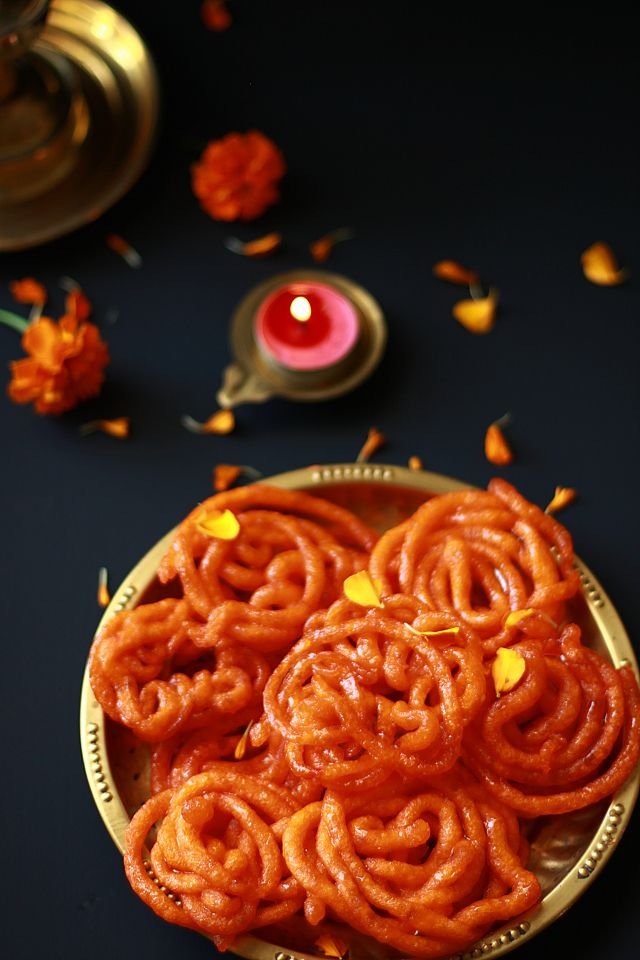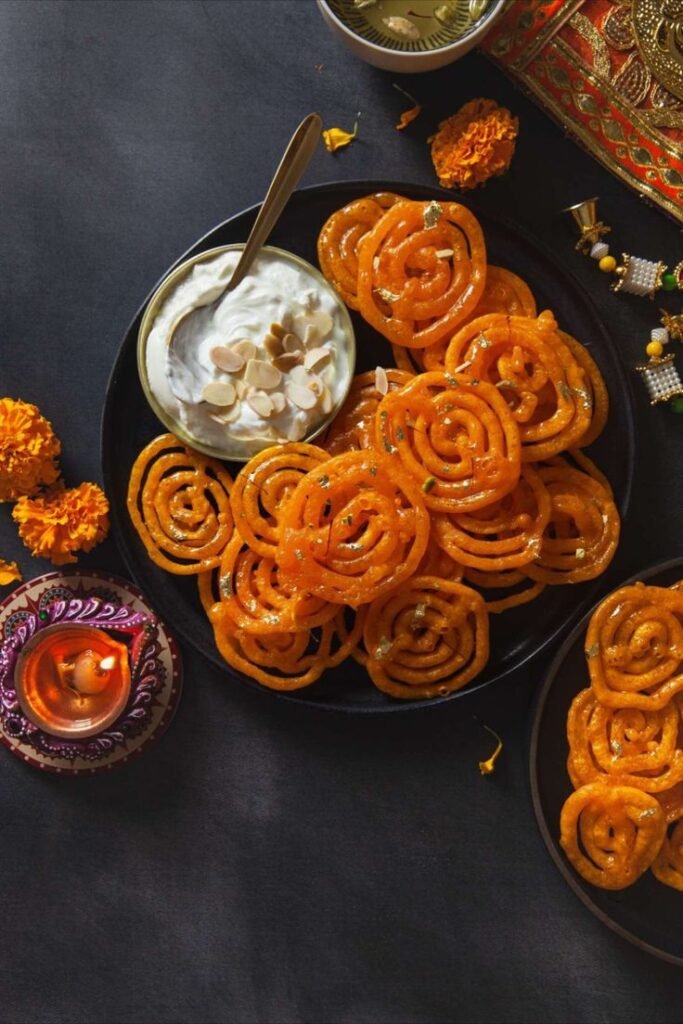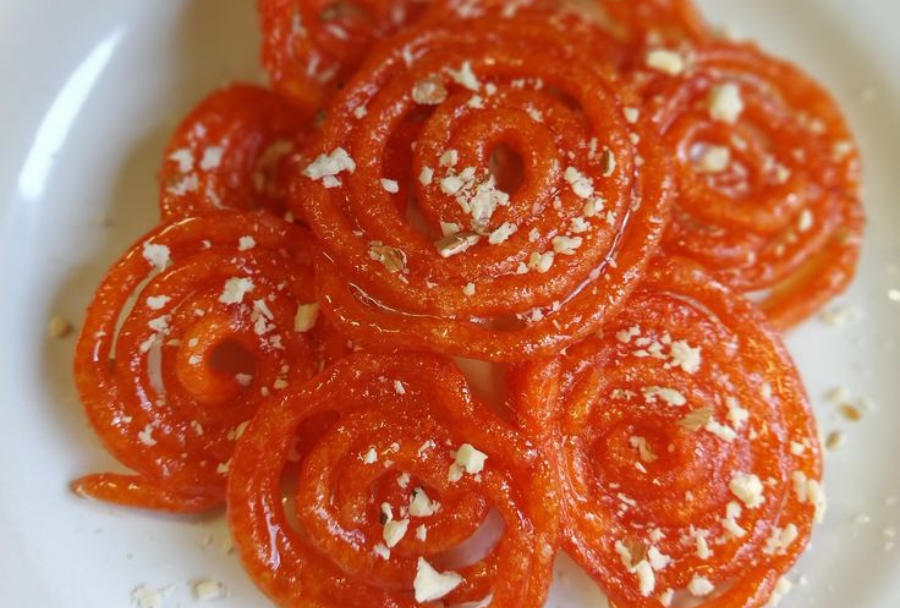Imarti is a traditional Indian sweet, loved for its striking spiral shape, glossy orange hue, and syrup-soaked juiciness. Often prepared during festivals like Diwali, Holi, and weddings, this dessert is made from urad dal (black gram lentils) batter, piped into intricate circular patterns, and fried in ghee or oil before being soaked in fragrant sugar syrup infused with saffron and cardamom. Its unique texture and appearance make it a centerpiece in festive spreads.
What makes this truly special is its combination of crispness and juiciness — the outer layer stays lightly crunchy, while the inside absorbs the sweet, aromatic syrup. Unlike its cousin jalebi, which is made with fermented flour batter, it has a denser, nuttier flavor profile owing to urad dal. Each bite bursts with sweetness, fragrance, and festive nostalgia, making it an iconic Indian indulgence.
This is also carries nourishing elements: urad dal provides protein and fiber, while saffron and cardamom bring antioxidants and warmth. Though rich, it offers a balance of taste and tradition when enjoyed in moderation.
With roots in Mughal and Awadhi cuisine, it has spread across India, often known as Jangiri in South India. Whether served as prasad, exchanged as festive gifts, or relished with family gatherings, Imarti represents festivity, artistry, and indulgence in every golden spiral.
What is Imarti?

This is a traditional Indian sweet, loved for its striking flower-like shape, vibrant orange color, and juicy, syrup-soaked richness. Made from ground urad dal (black gram lentils) batter, piped into intricate circular patterns, and deep-fried until crisp, It is then soaked in fragrant sugar syrup infused with saffron, cardamom, and sometimes rose water. Its crunchy exterior and syrup-filled interior make it an indulgent delight that melts in the mouth with every bite.
It is more than just a dessert — it is a festive indulgence, commonly enjoyed during Diwali, Holi, weddings, and temple offerings. The unique taste comes from its contrast of textures: a crisp golden crust with a juicy, syrupy core, delivering both sweetness and aromatic warmth in every piece.
What makes this truly special is its artistry — the batter is piped in concentric loops, forming a delicate flower-like pattern, which distinguishes it from its close cousin, Jalebi. While Jalebi is thinner and made from maida (refined flour), Imarti is thicker, more structured, and made from urad dal, giving it a slightly chewy yet soft bite and a nuttier flavor.
This also carries nutritional touches — urad dal contributes protein and energy, while saffron and cardamom add antioxidants and fragrance, making it both indulgent and wholesome when enjoyed in moderation.
History & Cultural Roots
It has deep roots in Indian culinary traditions, with its origins traced to North India, particularly Uttar Pradesh and Rajasthan, where it has been a festive and temple sweet for centuries. Often prepared as a prasad (offering) to deities, Imarti symbolizes prosperity, joy, and celebration.
Regional names and variations add to its charm:
- In South India, it is often called Jangiri, prepared with a similar urad dal batter but slightly different piping styles.
- In Bengal, Imarti sometimes features thicker syrup and floral essences like kewra.
- In royal kitchens of Rajasthan, saffron-rich versions were a sign of luxury and festivity.
Unlike everyday sweets, it is often reserved for special occasions — weddings, festivals, and fairs — where its bright orange rings symbolize abundance and festivity.
Even today, sweet shops across India prepare this fresh, often frying them in ghee for a more luxurious taste. Families buy them in dozens during festivals, relishing their crispy, syrupy charm together.
This stands apart as a sweet that combines craftsmanship, flavor, and tradition. Its bold sweetness, delicate design, and rich aroma make it a centerpiece of Indian festivities. Much like Gujiya, it is not just food but a cultural experience — a vibrant reminder of togetherness, celebration, and India’s rich culinary artistry.
Ingredients – Imarti
For the Batter:
- 1 cup urad dal (split black gram), soaked 4–5 hours
- 2–3 tbsp rice flour (optional, for crispness)
- Water, as needed for grinding
- A pinch of orange/red food color (optional, for traditional look)
For the Sugar Syrup:
- 2 cups sugar
- 1 cup water
- 3–4 green cardamom pods (slightly crushed)
- ½ tsp saffron strands or a few drops of rose water/kewra water (optional, for aroma)
For Frying:
- Ghee or refined oil, as needed
For Garnish (Optional):
- Edible silver leaf (varak)
- Chopped pistachios or almonds
Cooking Science: Why Imarti Works So Well

Imarti’s charm lies in its unique batter science, frying technique, and syrup infusion. The base is urad dal, which is rich in proteins and starch. When soaked and ground, the batter traps air, and vigorous whisking further aerates it, creating lightness and fluffiness. This aeration is crucial for achieving Imarti’s soft-yet-chewy texture.
Adding a small amount of rice flour improves crispness by reducing stickiness and giving structural strength. Food coloring (traditionally orange-red) gives its festive, jewel-like appearance.
The frying process is where the magic happens: the batter is piped in intricate, flower-like spirals directly into hot ghee or oil. The proteins in urad dal coagulate, while starches gelatinize, forming a crisp outer shell that holds its shape. Frying at medium heat ensures the Imarti cooks evenly—too hot would burn the outside while leaving the inside raw, while too low would make it oily and soggy.
Once fried, the hot Imartis are dipped in warm sugar syrup. Here, osmosis and capillary action work together: the porous urad dal structure absorbs just the right amount of syrup, coating the sweet with a glossy, sticky layer. Cardamom, saffron, or rose water in the syrup add aromatic complexity, elevating the flavor beyond just sweetness.
The result is a contrast of textures: crisp edges, a chewy body, and syrupy sweetness with floral and spicy undertones. Imarti stands out from its close cousin Jalebi due to its denser urad dal batter (instead of flour-based), giving it more chew, depth, and richness.
This fusion of legume chemistry, frying science, and syrup infusion makes Imarti an iconic festive dessert—especially during Holi, Diwali, and weddings—symbolizing indulgence, artistry, and togetherness.
Pro Tips Before You Start – Imarti
- Soak Urad Dal Properly: At least 4–5 hours (or overnight) for smooth grinding and better batter texture.
- Grind to a Fluffy Batter: Use minimal water; whisk well to aerate, as this ensures soft yet chewy Imartis.
- Add Rice Flour (Optional): A small amount improves crispness and prevents stickiness.
- Whisk Until Light: Batter should be airy and form soft peaks, which is key for the perfect shape.
- Use a Cloth or Piping Bag: Traditionally, a muslin cloth with a hole is used, but piping bags or squeeze bottles work well for neat rings.
- Maintain Oil Temperature: Fry on medium heat so Imartis cook evenly inside and out without burning.
- Shape with Patience: Practice steady hands while piping spirals for uniform flower-like designs.
- Soak in Warm Syrup, Not Hot: Warm syrup penetrates better; hot syrup may make Imartis soggy.
- Two-Minute Dip: Don’t leave too long in syrup—quick dipping ensures glossy sweetness without overpowering.
- Flavor the Syrup: Infuse with saffron, cardamom, or rose/kewra water for festive aroma.
- Serve Fresh: Imartis taste best when warm and juicy; avoid long storage as they lose texture.
Step-by-Step Method – Imarti
Step 1: Prepare the Batter
- Wash and soak urad dal for 4–5 hours. Drain and grind to a smooth paste with minimal water.
- Add rice flour (if using), food color, and whisk vigorously until fluffy and airy.
Step 2: Prepare the Sugar Syrup
- In a pan, combine sugar and water. Heat until it reaches one-string consistency.
- Add cardamom, saffron, or rose/kewra water for fragrance. Keep syrup warm (not boiling).
Step 3: Shape the Imartis
- Fill batter into a piping bag, squeeze bottle, or cloth with a small hole.
- Heat ghee/oil on medium flame. Pipe the batter directly into the oil in circular, flower-like spirals.
Step 4: Fry the Imartis
- Fry on medium heat until they turn golden and crisp on the outside but remain slightly chewy inside.
- Remove using a slotted spoon to drain excess oil.
Step 5: Dip in Sugar Syrup & Serve
- Quickly dip hot Imartis in warm sugar syrup for 1–2 minutes.
- Remove, let excess syrup drip, and garnish with pistachios, almonds, or silver leaf if desired.
- Serve hot and juicy for the best festive experience.
Watch the Video Tutorial
Prefer to watch step-by-step? Here’s a video that walks you through the process of making Imarti:
Watch Imarti Video Tutorial
Serving Suggestions – Imarti
Imarti is a jewel-toned festive sweet, loved for its crisp exterior and juicy, syrup-soaked interior. Traditionally served during Diwali, Holi, weddings, and temple offerings, this saffron-hued delicacy shines as both a dessert and a prasad.
Imarti, with its crisp exterior and syrupy core, is a festive highlight enjoyed during Diwali, Holi, weddings, and temple offerings. Best served warm or at room temperature, it shines on brass thalis, silver trays, or banana leaves for authentic presentation. Garnish with saffron strands, pistachios, almonds, or silver varq to enhance its festive appeal.
Pair Imarti with masala chai, kesar milk, badam doodh, or thandai for a traditional touch, or alongside mithai like jalebi and gulab jamun. For a modern twist, serve with rabri, vanilla ice cream, or rose syrup drizzle, while mini-Imartis work beautifully for buffets and fusion desserts.
Best enjoyed warm or at room temperature, Imarti retains its chewy texture and glossy finish. Present them on brass thalis, decorative trays, or banana leaves for an authentic festive vibe. To enhance the look, garnish with slivered pistachios, almonds, saffron strands, or silver varq.
Pair Imarti with masala chai, kesar milk, badam doodh, or chilled thandai for a complete festive experience. It also complements other Indian mithai like jalebi, gulab jamun, or laddu, making it an ideal centerpiece in a celebratory spread.
For a modern twist, serve Imarti with a scoop of vanilla or rabri-flavored ice cream, or drizzle with rose or saffron syrup for added indulgence. Mini-Imartis can also be plated as fusion desserts in buffets or weddings.
Nutritional Profile (Per Piece – ~40–45 g)
- Calories: ~150–180 kcal
- Protein: ~2–3 g
- Fat: ~5–7 g
- Carbohydrates: ~25–30 g
- Fiber: ~1 g
Imarti is mainly a source of carbohydrates and quick energy, thanks to urad dal batter and sugar syrup. The urad dal contributes a small amount of protein, while frying adds fats. Garnishes like nuts and saffron bring micronutrients and antioxidants. However, as it is deep-fried and sugar-rich, moderate consumption is recommended.
For a lighter version, Imarti can be air-fried or made with reduced sugar syrup, though the traditional taste lies in its rich syrup-soaked form.
Storage & Reheating – Imarti
Imarti should be stored in an airtight container at room temperature for up to 1–2 days to keep its crisp texture and syrupy juiciness. For longer storage, refrigerate for up to 4–5 days, though refrigeration can make the texture slightly chewy and less crisp. To avoid them sticking together, place parchment paper between layers.
Imarti stays fresh for 1–2 days in an airtight container at room temperature, preserving its crispness and syrupy juiciness. For longer storage, refrigerate up to 4–5 days, though it may turn slightly chewy. To prevent sticking, layer with parchment paper.
For reheating, avoid the microwave as it softens the texture. Instead, use a preheated oven or air fryer at 150–160°C for 3–5 minutes to revive crispness while retaining the syrupy core, or gently warm on a nonstick pan. When serving, present on festive trays or thalis, garnished with saffron strands, pistachios, or silver varq for an elegant finish.
For reheating, avoid the microwave as it makes Imarti soggy. Instead, place them in a preheated oven or air fryer at 150–160°C (300–320°F) for 3–5 minutes. This helps restore a light crispness on the outside while keeping the syrupy core intact. You may also lightly warm them on a nonstick pan over low heat for a quick refresh.
When serving for festive occasions, arrange Imartis neatly on brass thalis, silver trays, or colorful platters lined with banana leaves. Garnish with saffron strands, chopped pistachios, or edible silver varq for an elegant look. With proper storage and gentle reheating, Imartis retain their festive charm, glossy texture, and sweet indulgence.
How This Recipe Works – Imarti
Imarti’s appeal lies in the contrast between its crisp, lattice-like outer structure and juicy, syrup-soaked interior. The batter is prepared from soaked and ground urad dal (black gram), which provides the elasticity and airy texture necessary for shaping the spirals. Whipping the batter introduces air, ensuring the Imarti remains light and porous, ideal for absorbing sugar syrup.
The sugar syrup, often flavored with cardamom, saffron, or rose water, adds sweetness and aroma while coating the fried spirals with a glossy finish. Frying in ghee or oil at a steady medium temperature is crucial—too hot, and the Imarti browns quickly without cooking inside; too low, and it absorbs excess oil.
Once fried, immersing the Imarti in warm (not boiling) sugar syrup allows it to soak evenly without turning mushy. The result is a sweet that balances crispness, chewiness, and syrupy richness in every bite.Imarti’s charm lies in its crisp, flower-like shape paired with a juicy, syrupy core. Made from soaked and ground urad dal, the batter gains elasticity and lightness when well-whipped, allowing it to form intricate spirals.
Frying at a steady medium temperature ensures even cooking—too hot burns the exterior, too low makes it greasy. Once fried, the spirals are dipped in warm, cardamom- or saffron-flavored sugar syrup, which they absorb without losing their crunch. The result is a balance of crispness, chewiness, and aromatic sweetness. With a piping cloth or bottle, even beginners can master this festive delicacy.
Despite its intricate shape, the recipe is beginner-friendly with practice. A piping cloth, squeeze bottle, or traditional cloth with a nozzle makes shaping easier. This blend of technique, flavor, and festive artistry makes Imarti a timeless mithai loved across India.
Key Highlights – Imarti
- Unique Appearance: Bright orange, flower-shaped sweet with intricate swirls, resembling a festive jewel.
- Crispy & Juicy: Made with urad dal batter, deep-fried into spirals, and soaked in sugar syrup for a crunchy-yet-soft bite.
- Festive Favorite: A highlight during Holi, Diwali, weddings, and temple offerings.
- Distinct Flavor: Urad dal gives a nutty taste, while saffron, cardamom, and rose water in the syrup add rich aroma.
- Traditional Yet Versatile: Often paired with rabri or milk, but can also be enjoyed solo as a royal dessert.
Extended FAQs – Imarti
Q: What is the difference between Imarti and Jalebi?
A: Imarti is made with urad dal (black gram lentils) batter, giving it a thicker, chewier texture, while jalebi is made with maida (refined flour), resulting in a thinner and crisper finish. Imarti also has a more floral, intricate design.
Q: Can Imarti be made without food coloring?
A: Yes. Traditionally, saffron strands or natural annatto seeds were used for a golden-orange hue. Food coloring is optional.
Q: How long does Imarti stay fresh?
A: Best enjoyed fresh on the same day, but it can be stored in an airtight container at room temperature for up to 1 day, or refrigerated for 2–3 days. Reheat slightly before serving.
Q: Can I make Imarti ahead for festivals?
A: Yes, you can prepare the batter a few hours ahead and refrigerate. Fry and dip in syrup just before serving for the best texture.
Q: Why does my Imarti turn flat or break in oil?
A: This happens if the batter is too thin or the oil temperature is too low. Ensure a thick, well-whipped batter and medium-hot oil for perfect spirals.
Q: Is Imarti gluten-free?
A: Yes! Since it’s made with urad dal, it’s naturally gluten-free, unlike jalebi which uses wheat flour.
Conclusion
Imarti is more than just a sweet—it’s a festive symbol of artistry and indulgence. Its intricate flower-like design, deep-fried crispness, and sugar-soaked juiciness make it a showstopper on any celebratory table. Traditionally offered during festivals and weddings, it carries a cultural heritage that blends devotion, joy, and culinary skill. Whether paired with rabri, warm milk, or enjoyed on its own, Imarti delivers a rich taste of Indian tradition in every bite.


